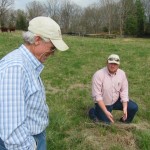Mob grazing…the soil report
 It was a year ago that we began our experiment with mob grazing at Thistle Hill. And here, agricultural land consultants Charlie Thornton (foreground) and Tim Woodward of Tellus Consulting help us consider the results.
It was a year ago that we began our experiment with mob grazing at Thistle Hill. And here, agricultural land consultants Charlie Thornton (foreground) and Tim Woodward of Tellus Consulting help us consider the results.
Tellus did a complete mineral analysis of seven of our pastures using Brookfield Labs in Ohio. We tested three of our mob grazing pastures against others that were used in the usual way.
Mob grazing puts more pounds of beef on a very limited area and moves the animals off quickly to the next small area. The belief is that this “pressure” will result in more fertile soil, more organic matter because of the trampling effect, better use of all the plants, and healthier cows because they’re eating only the tops of the grass and then move on.
Our “eye” told us we had probably had a more efficient use of the grass but we also saw some signs we didn’t like: more weeds, bare patches of soil. Tim in the picture is pointing out a patch of dead foxweed and beneath it the soil is bare. Not good. That’s a place that will take a while to repair and it also is a place where ground temperature will be higher and water-holding capacity will be less.
Some of that is our fault. We didn’t move the cows off this area quickly enough and that permitted the foxweed to take hold. But that’s not the entire story. And there are other, more troubling weeds, like rosa-multiflora, taking hold that will have to be battled.
As for the soil itself, the reports are indeterminate. Our fertility was generally good to begin with and that continues to be the case. We need to add a little Boron in a few pastures, but that was unrelated to mob grazing. PH was excellent across the board…..very close to 6.5 everywhere though maybe slightly better in the mobbed areas.
The clearest indication that mob grazing made an improvement was organic matter, definitely better in our mob pastures versus the nearby standard pastures.
So what will we do? First, spray a natural, liquid Boron on those areas that need it. We will also lime a few pastures which were closer to 6 than 6.5 to bring up their pH. That’s a “tweaking” exercise; we don’t want to get the pH too high.
The most difficult job will be getting rid of the weeds. We’ll use mowing and machetes. Not herbicides. And wherever possible, we’ll dig out the roots on the Rosa-multiflora. But that’s going to be an on-going battle.
Are we satisfied that mob grazing is the answer for us? A tough question and the honest answer is: not yet. We said we would try this for two years and we’ve already begun Year Two. You can see the cows in the background of the picture in the first paddock. We have decided to make some modifications: giving them bigger paddocks, moving them faster, and (totally breaking the rule) knocking down weeds before they mature. That means bush-hogging, which we thought we were through with.
Most painful: we have decided our stocking rate is just a little too high for the amount of land we have….particularly with a group of English heifers due to arrive in about a month. So five of our mamas are going to have to go. A tough decision.
Finally, we’ll review all this with our colleagues in the Pilot Project we’re a part of sponsored by Holistic Management International. We’ll compare notes…check with the experts…and further refine our plan.
2 Comments
Rich Hamilton
Well, we are understocked – significantly – any chance we could work something out to provide those mamas a new home??
David
We certainly should be able to work something out. But not here, where the whole world is watching. I noticed yesterday that we even have a reader on the Norfolk Islands!